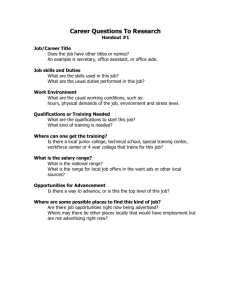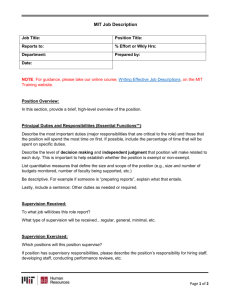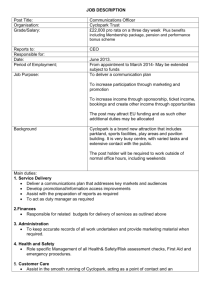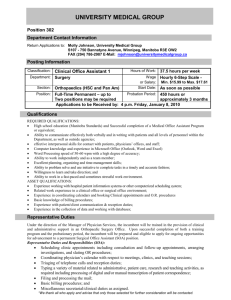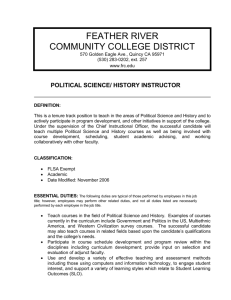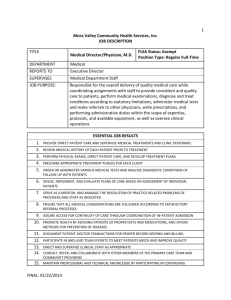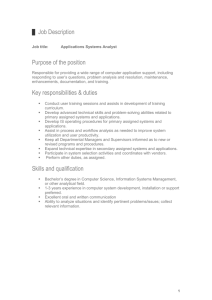Position Description - Madison Area Technical College
advertisement
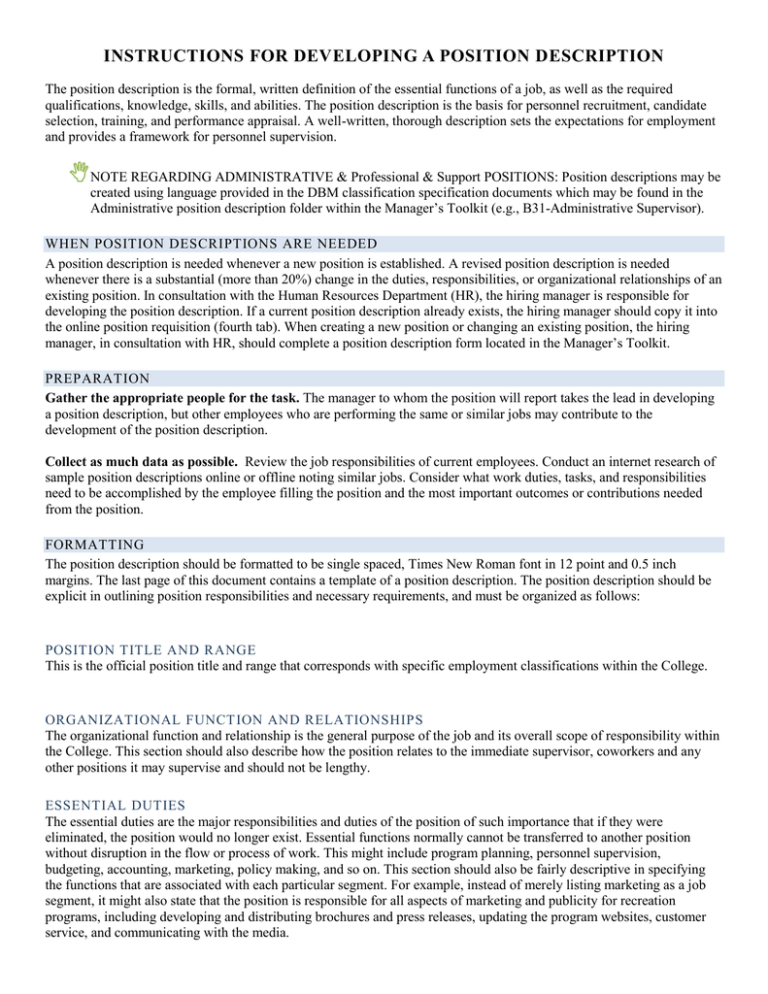
INSTRUCTIONS FOR DEVELOPING A POSITION DESCRIPTION The position description is the formal, written definition of the essential functions of a job, as well as the required qualifications, knowledge, skills, and abilities. The position description is the basis for personnel recruitment, candidate selection, training, and performance appraisal. A well-written, thorough description sets the expectations for employment and provides a framework for personnel supervision. NOTE REGARDING ADMINISTRATIVE & Professional & Support POSITIONS: Position descriptions may be created using language provided in the DBM classification specification documents which may be found in the Administrative position description folder within the Manager’s Toolkit (e.g., B31-Administrative Supervisor). WHEN POSITION DESCRIPTIONS ARE NEEDED A position description is needed whenever a new position is established. A revised position description is needed whenever there is a substantial (more than 20%) change in the duties, responsibilities, or organizational relationships of an existing position. In consultation with the Human Resources Department (HR), the hiring manager is responsible for developing the position description. If a current position description already exists, the hiring manager should copy it into the online position requisition (fourth tab). When creating a new position or changing an existing position, the hiring manager, in consultation with HR, should complete a position description form located in the Manager’s Toolkit. PREPARATION Gather the appropriate people for the task. The manager to whom the position will report takes the lead in developing a position description, but other employees who are performing the same or similar jobs may contribute to the development of the position description. Collect as much data as possible. Review the job responsibilities of current employees. Conduct an internet research of sample position descriptions online or offline noting similar jobs. Consider what work duties, tasks, and responsibilities need to be accomplished by the employee filling the position and the most important outcomes or contributions needed from the position. FORMATTING The position description should be formatted to be single spaced, Times New Roman font in 12 point and 0.5 inch margins. The last page of this document contains a template of a position description. The position description should be explicit in outlining position responsibilities and necessary requirements, and must be organized as follows: POSITION TITLE AND RANGE This is the official position title and range that corresponds with specific employment classifications within the College. ORGANIZATIONAL FUNCT ION AND RELATIONSHIPS The organizational function and relationship is the general purpose of the job and its overall scope of responsibility within the College. This section should also describe how the position relates to the immediate supervisor, coworkers and any other positions it may supervise and should not be lengthy. ESSENTIAL DUTIES The essential duties are the major responsibilities and duties of the position of such importance that if they were eliminated, the position would no longer exist. Essential functions normally cannot be transferred to another position without disruption in the flow or process of work. This might include program planning, personnel supervision, budgeting, accounting, marketing, policy making, and so on. This section should also be fairly descriptive in specifying the functions that are associated with each particular segment. For example, instead of merely listing marketing as a job segment, it might also state that the position is responsible for all aspects of marketing and publicity for recreation programs, including developing and distributing brochures and press releases, updating the program websites, customer service, and communicating with the media. Before listing the essential duties, include the following language: “The following duties are typically expected of this position. These are not to be construed as exclusive or all-inclusive. Other duties may be required and assigned.” KNOWLEDGE, SKILLS, AND ABILITIES Required Knowledge, Skills and Abilities (KSA’s) are the qualifications that cannot be easily learned. Knowledge – Accumulation of understanding gained from formal education and/or training or past job experience that the applicant would be required to possess in order to meet the prerequisites of the position. For example, knowledge of personal computers implies possession of the concepts for their use. Skills – Proficiency that can be demonstrated, such as operating a machine. Abilities – Competence to produce an observable product, such as ability to work effectively with clients, or ability to communicate an abstract idea. Be sure to include the following two KSA’s in position descriptions: “Skill in communicating effectively, both orally and in writing” as well as “Demonstrated skill in communications and human relations with populations of diverse socioeconomic and cultural backgrounds and persons with disabilities.” QUALIFICATIONS The qualifications of the position description outline the minimal qualifications necessary for the particular job, including both level of formal education and length and type of experience. In general, academic qualifications include education levels, degrees, and areas of study. Professional qualifications include requirements for licensure, certification, or other credentials. Core educational and work experience qualifications for positions are predetermined by the Wisconsin Technical College System or the Madison College classification system and will be provided to the hiring manager by HR. All qualifications must be job-related and set no higher than necessary to perform the duties described. A rule of thumb to consider is that as requirements become more specific, the potential applicant pool shrinks. HUMAN RESOURCES REVIEW & APPROVAL Human Resources must review position descriptions to ensure that they are properly formatted, understandable, reasonably brief, prepared in accordance with the guidelines, and contain the information needed for classification purposes. HR must ensure that they are not in conflict with other position descriptions or known facts about the position. When a position description is unsatisfactory, it will be returned to the hiring manager for revising. If HR is unable to obtain an accurate position description from the hiring manager, the position may be audited with appropriate audit notes prepared, attached to the position description and used in the classification of the position. HR approves, finalizes and distributes the position description following classification. MADISON AREA TECHNICAL COLLEGE POSITION DESCRIPTION POSITION TITLE: TITLE OF POSITION – DEPARTMENT/SCHOOL (RANGE XX OR DBM XX) ORGANIZATIONAL FUNCTION AND RELATIONSHIPS This position is responsible for (State which positions will report to this position, if any-Example: Casuals and student workers may report to this position). This position reports to ESSENTIAL DUTIES: The following duties are typically expected of this position. These are not to be construed as exclusive or all-inclusive. Other duties may be required and assigned. 1. 2. 3. 4. 5. 6. (align numbers with the left-hand margin and indent .5 inch) KNOWLEDGE, SKILLS AND ABILITIES: 1. 2. 3. 4. 5. 6. (align numbers with the left-hand margin and indent .5 inch) Skill in communicating effectively, both orally and in writing. Demonstrated skill in communications and human relations with populations of diverse socioeconomic and cultural backgrounds and persons with disabilities. QUALIFICATIONS: 1. **Experience used as an equivalent of an educational requirement is in addition to any experience required by the position. ** 2. 3.
